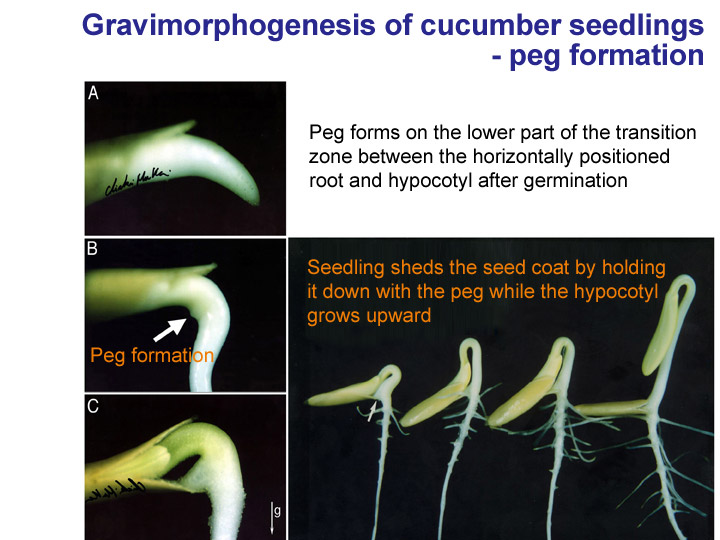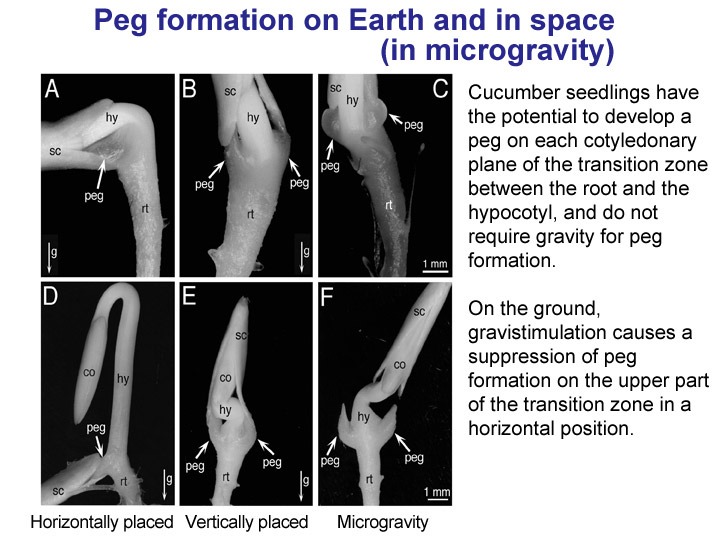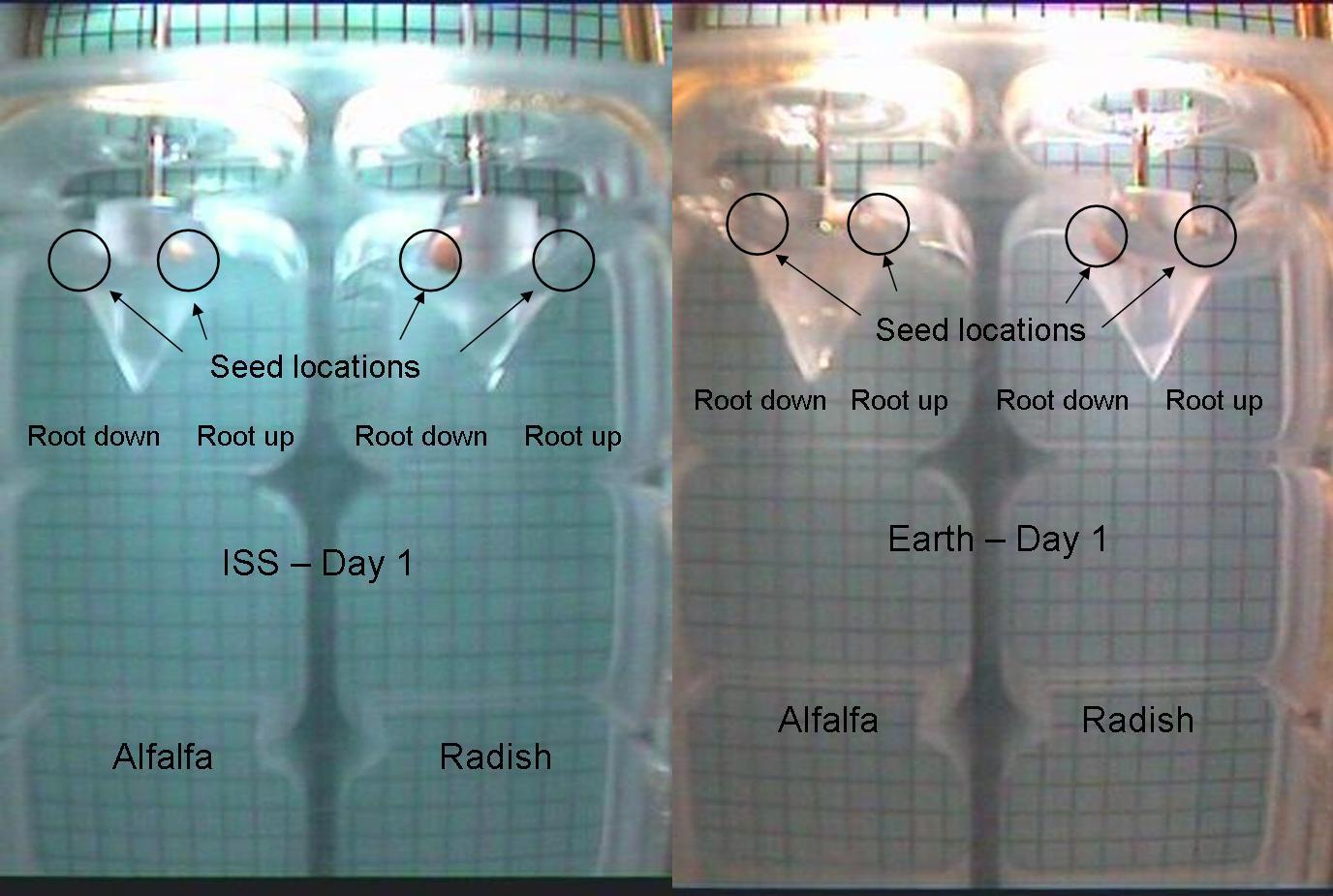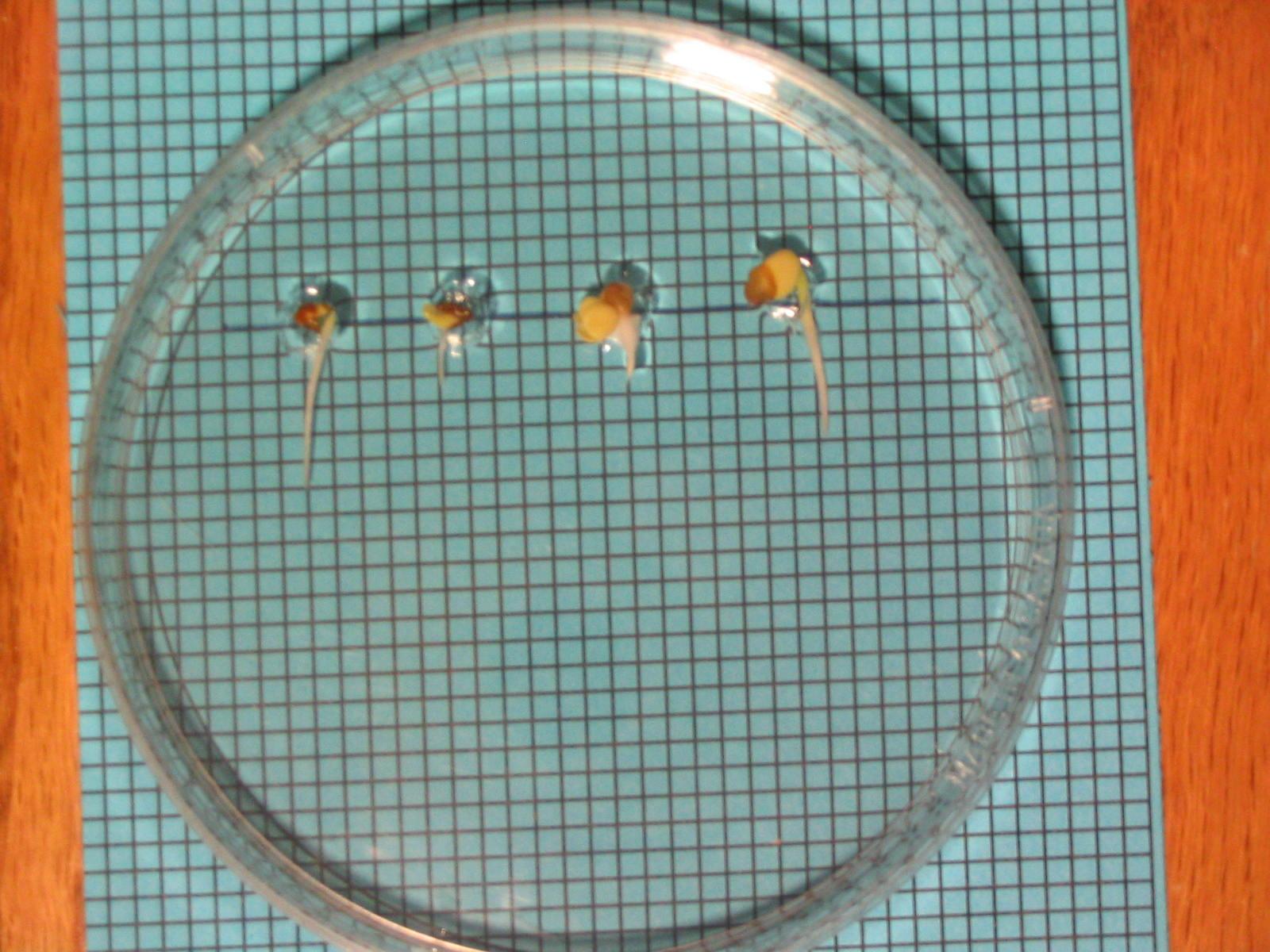There have been numerous experiments into plant growth in space. It's important to scientists on the ground because it can help us better understand how plants function which can help us to grow food more efficaciously. It's also important to NASA, because when we finally start sending astronauts away from low Earth orbit, they may need to grow their own food and maintain their own regenerable atmosphere.
人们已经做了许许多多关于植物在太空生长的实验,因为这些实验帮助那些在地表科学家们更好了解植物的运作方式以帮助我们更有效的生产事物,对于美国航天航空局(NASA)来说了解这些同样重要,因为当我们开始将航天员送往低地球轨道,他们就有必要种植自己的植物以及维持空气的可再生。
Gravity is not the only difference between the Earth environment and the ISS environment. In the closed atmosphere of a spacecraft, volatile organic compounds (VOCs) can accumulate. VOCs need to be scrubbed from the air or seed production will suffer. There are elevated radiation levels that can cause mutations and affect growth. An experiment on Mir, that involved storing tomato seeds in space for six years found mutation rates up to 20 times higher in the space seeds than in the control seeds stored on the ground. And there are the spectral effects of using only electric lighting.
相比地表与国际空间站(ISS)的环境来说重力不是唯一不同的因素,在封闭宇宙飞船大气中,可挥发的有机物质(VOCs)可以积累下来,而这些物质必须将其从大气或者种子产物中去除(控制变量),同时宇宙环境中有过量的射线可以导致植物的变异以及影响植物的生长,Mir做了一个实验,它将土豆的种子分别贮藏在太空与地表六年发现太空种子的突变率是地表的20倍或更高,这里还有一个关于光谱的影响太空中因为只使用了电气照明。
Because plants also respire, we have to have fans to circulate the air around the plants so that they don't suffocate on their own exhalations. Even failed experiments can provide us with better understanding. An experiment to study plant lignin failed to produce healthy plant materials but taught us more about providing effective air movement.
**因为植物在无时无刻保持着呼吸,所以在ISS中我们不得不安置了一台风扇以使的周围的空气流通是植物免于被自己的呼出的气体弄窒息,即便是失败的实验也能够帮助我们更好的理解科学,一个研究木质素(lignin)的实验在培养植物材料的阶段失败了却让我们了解了提供有效空气流通的重要性。 **
In the absence of weight, there is poor water and air movement through the rooting media. One complication we've discovered is that in microgravity, the water distributes evenly throughout the soil. This can actually prevent air from reaching the roots. That's why 'Veggie' uses wicks - so that water is only distributed to selected areas. It's also why a lot of study has gone into selecting the best soils. Fine grained soils hold too much water and coarse soils hold too much air.
** 由于在太空失重,只有很少的水分和流动的空气通过生根培养基,一个失重照成的并发症就是水分会均匀分布在土壤中使得气体无法到达根系,这就“Veggie”(一项太空植物研究)使用wicks,以便让水分布在选择的区域,这就是为什么许多研究选择最好的土壤,好的细粒土保持了太多的水分而粗粒土保持了太多的空气。**
Tropism is a growth response between a plant and external stimulus. There are numerous forms of tropism and understanding each of them greatly affects our abilities to grow healthy plants. One of the cool things about experimenting on the ISS is that we can study each form of tropism in isolation. On Earth, gravity tends to overwhelm the other influences.
向性:一种植物生长方式取决于植物本身及外界环境的刺激,植物有许多的极性,它们对我们种植出健康的植物有巨大的影响,说一件有趣的ISS经历,我们可以在隔离(isolation)的环境中研究各种向性,而在地球上,重力往往要大于其他的因素。
Gravitropism is when the external stimulus is gravity. Plants have a hormone called auxin. In a gravity environment, if a plant is oriented on its side, auxin will accumulate in the stem and stimulate cell expansion that will result in the stem bending to point upwards so that the stem grows towards light (the sun). Similarly, auxin prevents cell elongation in the roots and that encourages roots to grow downwards.
向地性:当存在重力时,植物有一种称之为生长素(auxin)的植物激素,在重力环境中,当植物极性分化后,生长素会在茎中积累然后刺激细胞伸长,导致茎干发生弯曲向上生长以便植物能够向着光源的方向生长,同样的生长素能够防止细胞伸长以及促进根系向下生长。
When plants grow, they do so in an oscillatory or helical manner called circumnutation. We can easily see this in vines that grow around an object. An interesting experiment was done aboard the ISS to study this in the absence and presence of gravity in the space environment. Arabidopsis plants were grown from seeds in space and observed both in the normal microgravity environment and in a centrifuge that simulated 0.8 g. While under the 0.8 g, the plants experienced circumnutation amplitudes 5-10 times as high as in microgravity. Within the endodermis of the planet there are gravisensing cells. On a larger scale, this may mean that vines cannot twine in space.
当植物生长时,会发生摇摆或者旋转方式叫做回旋运动(circumnutation),我们可以容易的看到这些藤围绕着一个物体生长,在ISS上我们做了一个有趣的实验,分别在失重(absence gravity)和存在重力(presence gravity)的条件下,拟南芥(Arabidopsis)在太空中发芽,观察它们在失重环境和在0.8g刺激的离心机(centrifuge)中的表现,在0.8g刺激下,植物有规律的(experienced)回旋运动振幅5-10次远比失重(microgravity)环境要高,植物内胚层(endodermis)是重力敏感(gravisensing)细胞,也就是说,这意味着藤无法在失重的环境下缠绕(twine)。
An interesting thing learned from studying cucumber growth in space involves a structure called a peg that develops immediately after germination, between the root and stem. This peg has long been observed and the scientists were interested to see if it was dependent on gravity. What they learned was that each seed is structured to grow two pegs - one on each side - but in the presence of gravity, only one peg develops, whereas both are activated in microgravity.
可以从黄瓜(cucumber)的研究中发现一些有趣的事,太空中生长的黄瓜在发芽后在根和茎的地方会长出具有一个被称为夹子(peg)的结构,科学家们一直在观察这些peg是如何受到重力的影响的,他们只知道每颗种子会葬两个pag,左右各一个,但在重力环境下只有一边的pag会生长,而在失重环境下两边都会。




*Studies indicate that a plant's perception of gravity is related to the presence of starch in the organelles within the cell structure of the roots. Roots with starch appear to be more sensitive to gravity that roots that are missing the starch. *
研究表明地球的重力的感知与根结构细胞器中的淀粉(starch)有关,那些根中富含淀粉的相比不含淀粉对重力更为敏感。
Hydrotropism is when the external stimulus is water. Cucumber plants are particularly dependent on gravity to initiate growth. An experiment called Hyrop Tropi was conducted in the Japanese laboratory aboard ISS, in 2010. The experiment was designed to investigate two major objectives; one was to see if roots of cucumber seedlings would bend toward water when they grow in microgravity, and the other was to identify Auxin-regulated genes. This was a neat example of an experiment that needed microgravity. It would be difficult to study the role of water on Earth, because we can't easily remove the effects of gravity, but in space we could ensure that water was the only stimulus. Here's a brief summary of the results, from the principal investigator.
向水性:当外界刺激为水时,黄瓜特别的依赖水来启动生长,一项正在进行的叫做Hyrop Tropi 的日本实验项目在ISS上进行,2010年时,项目设计研究了两个主要的对象,一个是研究在失重环境下黄瓜根系萌发的轻水性,其他组则负责识别生长素调控基因,这是一个严格的(neat)实验因此需要在失重环境下进行,这与在地球上研究水的角色十分的不同,因为我们不可能轻易的摆脱引力的影响。但是在太空中我们则可以让刺激唯一,这是一则论文的简要概括。
- The results showed that roots hydrotropically bent toward the moistened plastic foam under microgravity conditions, whereas they grew straight along the direction of gravitational force under 1G conditions. The hydrotropic response in microgravity appeared to be greater in the NaCl chamber compared with that in H2O chamber, but they did not differ statistically. Furthermore, CsIAA1 gene differentially expressed in the hydrotropically bending roots; the expression was much greater on the concave side than on the convex side. On the other hand, no asymmetric expression of CsIAA1 in the roots grown under 1G conditions were detected. These results revealed that roots become very sensitive to moisture gradients in microgravity and that auxin redistribution and differential auxin response take place during hydrotropic response. Also, the results imply that the hydrotropic response can be used as a means of root growth regulation for plant production in space. (Hydrotropism and Auxin-Inducible Gene expression in Roots Grown Under Microgravity Conditions)
结果表明在失重与1G引力(gravitational)环境下根系在湿润可弹性海绵的方向生长研究亲水性,亲水性在失重环境下表现出比H2O室更大的NaCl室,但是它们并没有出现统计学上的不同,此外,CsIAA1基因在弯曲的根中表现不同;表达在弯曲的凹面相比在凸面更巨大,而在1G引力的环境下基因并没有非对称(asymmetric)表达,这些结果发现在失重环境下湿度的渐变(gradient)会会使根系变得更加敏感,并照成生长素的重新分配,在亲水响应中不同的生长素长生,并且,这项研究暗示着向水性反应可以作为一项有意义的根系生长调节在太空的植物种植中。
Phototropism is when the external stimulus is light. In some of the pictures from space you'll notice that the lighting is red-blue in the plant habitat. Red-blue light that has been deemed most efficacious for photosynthesis.
向光性:当外界刺激为光照的时候,从一些宇宙的照片可以发现宇宙发出的光为红蓝光,红蓝光被认为是光合作用最高效的光源。
Other tropisms that can be studied are chemotropism (chemicals), thigmotropism (touch), and electrotropism (electric fields)In April, a SpaceX cargo vehicle delivered a plant growth chamber that the payload investigators call 'Veggie*'. The astronauts will use it to grow foods. 'Veggie' utilizes small bags of soil with inserted wicks to provide water. *
其它可以被研究的的向性包括化学向性(chemotropism),扰(触碰)向性(thigmotropisum)及电场向性(electropisumn),四月份,一枚运输植物生长室(chamber)的叫做“Veggie”的SpaceX运载火箭,宇航员将会使用其生产事物,“veggie”利用穿插着灯芯的突然以提供水分。
One area that we don't yet have a lot of understanding is how much the spaceflight environment will influence metabolite production. Metabolites affect flavor and nutritional quality. The plan is to return early 'Veggie' crops to Earth to study the metabolites.
一个我们还不太了解的领域就是太空飞船环境如何的影响植物的代谢(metabolite),代谢影响着事物的味道(flavor)以及营养物质的含量,于是计划尽早将“Veggie”作物运回地球研究测定。
How Do Plants Grows in Microgravity?——Hideyuki Takahashi
I am interested in how plants adapt to and evolve in the space environment. Previous spaceflight experiments have confirmed that, as long as the environment is controlled with the right hardware, seeds can germinate, the resulting seedlings can grow, and the mature plants can bloom and bear fruit in space. However, the degree of growth is a different matter. A microgravity environment has a great impact on plant growth and development, and it eventually affects plant yield.
When plants migrated from the sea approximately 450 million years ago, they became land organisms. To do so, however, they had to overcome various environmental stresses, such as drought, in their terrestrial life. In order to avoid such stresses, sessile terrestrial plants evolved strategies to perceive light, water and gravity, and to respond to them by changing their growth orientation. Among these adaptive strategies, is gravimorphogenesis, in which plant growth is influenced by gravity. Examples of this phenomenon are: gravitropism, where roots grow downward and stems grow upward; circumnutation, where the stem or the root tips display helical or spiral movement (for example, a climbing vine shows remarkable circumnutation); and peg formation, which helps cucurbitaceous seedlings shed their seed coats . The space environment is an ideal place to study these mechanisms of gravity-dependent growth in the development of plants.
Gravitropism is a bending response, accomplished by differential growth of plant organs in response to gravity. On the space shuttle flight STS-95, which included Astronaut Chiaki Mukai, experiments were conducted to compare ground-grown and space-grown Arabidopsis and rice. On Earth, aerial parts of the plant (shoots) grow upward while roots grow downward. However, the experiments showed that in a microgravity environment, the growth direction is unregulated, and some roots even extend in the same direction as the aerial stems . In the case of root gravitropism, the hypothesis is that gravity is perceived by root cap cells, called columella, which are found at the root tips. Within the columella cells, starch-filled amyloplasts settle due to gravity, causing a change in the flow of the plant hormone auxin.
In essence, auxin characteristically flows in a fixed direction, from an aerial shoot, including the apical meristem and young leaves, towards the roots, through a central cylinder. After flowing down to the root tips by this polar transport, auxin begins to flow in the opposite direction, as if making a U-turn, along the roots. When roots are inclined and given gravitational stimulus, however, U-turning auxin tends to go downward instead of upward. As a result, the concentration of auxin increases in the lower part of the elongation zone in the inclined roots, causing a differential growth between the lower part and the upper part; the growth rate of the lower part decreases compared to that of the upper part causing the root to bend downward. This is how plant roots on Earth grow downward in response to gravity. However, in microgravity, amyloplasts do not settle within the root cap cells, so gravity is not perceived, nor is asymmetric auxin distribution induced. This is why, presumably, growth direction is uncontrolled in space.
You have probably seen Morning Glory vines growing upward, spiraling around a pole. This is thanks to circumnutation, which also has something to do with gravity. Previous studies have shown that stem circumnutation requires an endodermis, surrounding vascular tissue and made up of gravisensing cells. In a nutshell, without the so-called SCARECROW gene, which is essential for the proper differentiation of endodermal cells, the Morning Glory cannot sense gravity, and as a result, cannot circumnutate - its vines cannot twine. This indicates that circumnutation and spiral growth are gravity-dependent phenomena. I am very much looking forward to seeing whether circumnutation, or twining of vine plants, can be observed in the weightlessness of space.!
Peg formation on cucurbits - the plant family that includes cucumbers, melons and squash - is also influenced by gravity. A peg, which is a small protuberance, develops immediately after germination in the transition zone between root and stem . On Earth, the downward growth (gravitropism) of the roots results in a curvature at the transition zone. When seeds germinate in a horizontal or inclined position, a peg develops on the lower, concave side of the bending transition zone at an early stage of seedling growth. As such, it had been presumed that peg formation was regulated by gravity. When we germinated cucumber seeds in space , a peg formed on each side of the transition zone, showing that pegs develop with or without gravity. In other words, cucumber seedlings have the innate ability to develop two pegs, but on Earth, the seedlings suppress peg formation on the upper side of the inclined transition zone in response to gravity, which causes unilateral placement of the peg in cucumber seedlings. This gravity regulation has something to do with auxin, the plant hormone I mentioned earlier.
To sum up, plant life depends on gravity, and auxin transport, which is regulated by gravity, plays an important role. It is thought that in the weightlessness of space the absence of gravity to regulate auxin transport results in abnormal growth and development of plants. However, exactly how gravity regulates auxin transport remains unknown. When this mechanism is understood, it will not only improve plant production on Earth, but will also help with plant cultivation in space. So, it is very important to perform space experiments that will clarify the mechanisms of plant growth and development.Dr. Hideyuki TakahashiProfessor, Graduate School of Life Sciences, Tohoku UniversityIn 1982, Dr. Takahashi received his Ph.D. in Agriculture from the Graduate School of Agricultural Science at Tohoku University, and a postdoctoral fellowship at the Department of Biology at Wake Forest University, in North Carolina, USA. He was a research associate at the Institute for Agricultural Research at Tohoku University from 1985 to 1987, and at the Institute of Genetic Ecology at Tohoku University in 1988. The following year he was a visiting fellow at the Department of Biology of the University of North Carolina at Chapel Hill (North Carolina, USA). Subsequently, Dr. Takahashi was appointed associate professor, and as of 1996, a full professor, at the Institute of Genetic Ecology at Tohoku University. He has been in his current position since 2001.